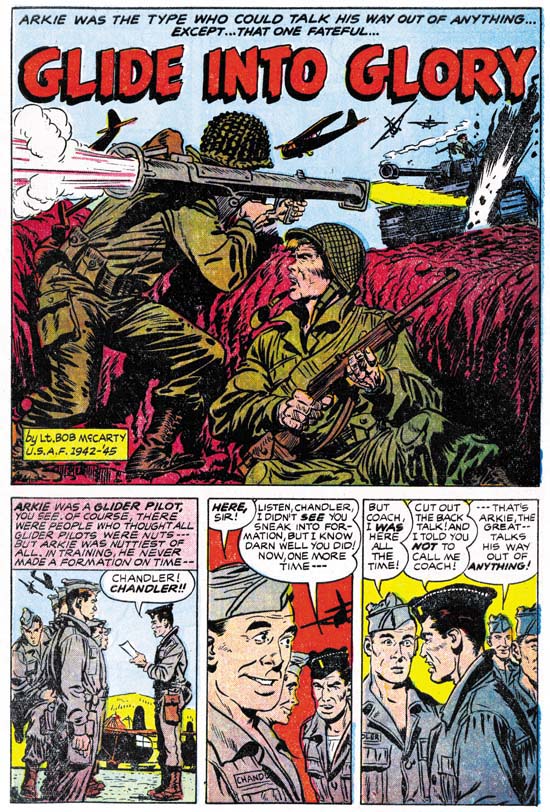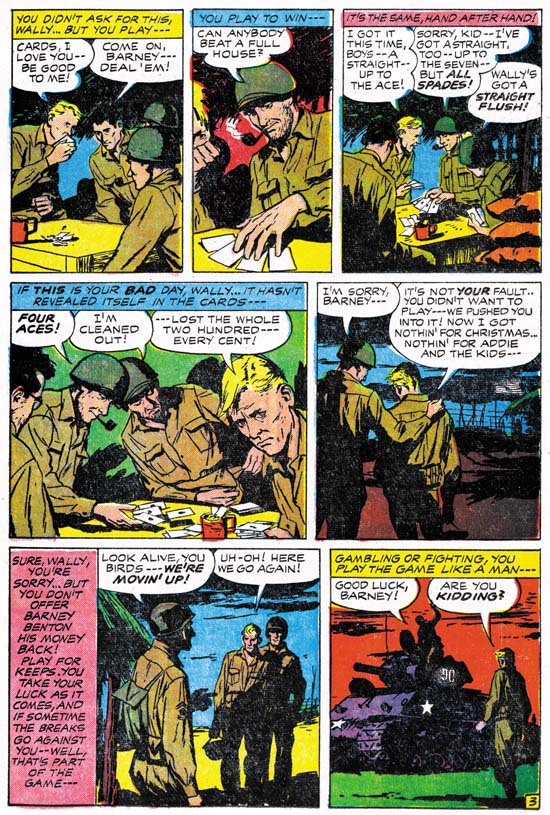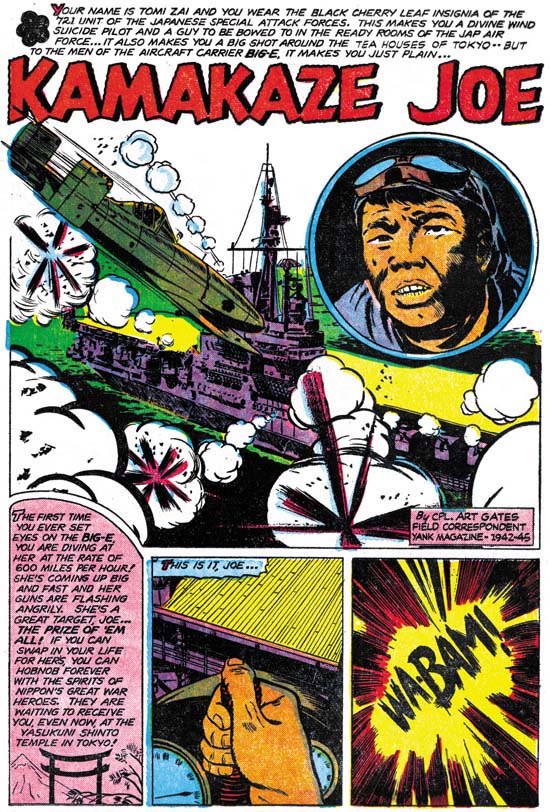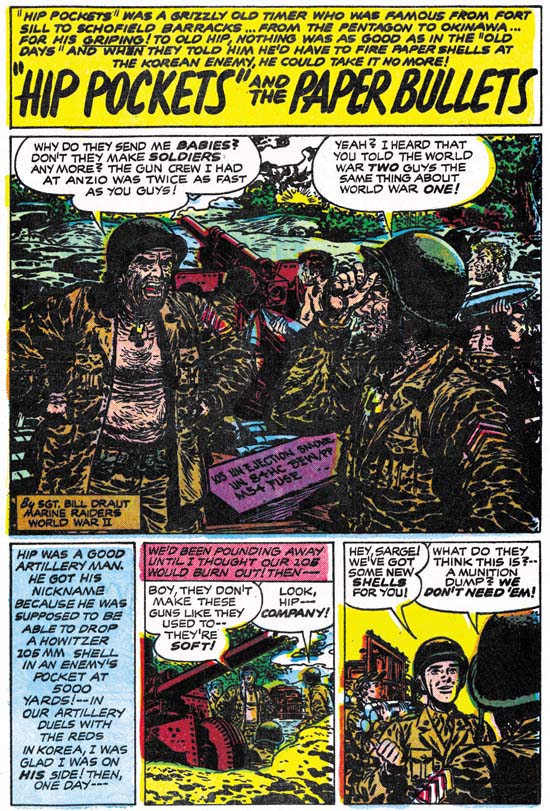Criticism of comic books by some of the public resulted in decreased sales. This was particularly felt by EC which published some of the more objectionable titles. In a domino affect, decrease EC sales lead to financial problems for their distributor Leading News which in turn created difficulties for Simon and Kirby’s new publishing company Mainline that used the same distributor. Eventually S&K had to shutdown Mainline and they then went to Charlton to publish their titles. While the titles had been on a bimonthly schedule, the first Foxhole issue published by Charlton came out with an extra month delay. The whole change in publishers must have been somewhat unexpected because although this was Charlton’s first issue it had a postal declaration which still listed Mainline as the publisher.

Foxhole #5 (July 1955) “Glide Into Glory” page 1 art by Bob McCarty
“Glide Into Glory” is about Arkie a wacky glider pilot. Are there any other kind? I see no reason to go into details about some of these Foxhole stories but that is not to say they are not good stories. We have seen Bob McCarty’s work before and here he continues to provide his quality art. The script is also entertaining. I guess the moral of the story is how important the independence streak of Americans was to winning the war.

Foxhole #5 (July 1955) “Lucky Stiff” page 3 script by Jack Kirby art by Joe Albistur
Another Kirby and Albistur team up in a story about Wally, a soldier who seems to have all the luck and Barney who wished he had. We previously saw Kirby provide a script that almost seemed appropriate for Black Magic. While “Lucky Stiff” is not so extreme it is still a rather off beat story. I will say that although I understand what Kirby was trying to do I do not feel the end was quite as successful as it should have been. Albistur for his part provides some rather nice art. I like the way he cuts off much of Barney’s face in the second panel of page 3 shown above. I think it is very effective in providing just of note of Barney’s frustration in a panel otherwise devoted to Wally’s calm good fortune.
As I said this is our second example of Jack Kirby as a writer. We have also seen two stories that Jack drew (“Booby Trap” and “Hot Box“). Jack did seem to make writing changes to the stories he drew. In both of these Foxhole stories drawn by Kirby there are small speeches that seem so typical of Jack. This sort of laconic retort shows up not only in other S&K productions drawn by Kirby but in work that Jack did late in his career. These Kirby-ish dialogs do not occur in S&K comics drawn by other artists. Now that does not particularly surprise me but I do find it unexpected that the two examples of Kirby as writer in Foxhole also lack these small Kirby speeches. While it is possible that Jack just did not feel they were appropriate for these stories, I suspect that it reflects on the type of artist Jack was. The scripts that Kirby provided Albistur are rather good but that was not the way Jack preferred to work. It is not so much that Jack was a visual artist as that it was hard for him to separate the writing portion of story telling from the drawing part. Jack’s scripts were more personal when the writing and drawing were done simultaneously.

Foxhole #5 (July 1955) “Kamakaze Joe” page 1 art by Art Gates
“Kamakaze Joe” starts with the main character flying his plane into the “Big-E” (the USS Enterprise, an aircraft carrier). This may seem to be more appropriate for near the end of a story, but it was a really effective choice by the writer. After this unusual start, we are taken back to trace the personal history of this Japanese pilot. Here Art Gates really shines. I am sure there was a lot of swiping done but Art has illustrated a story that really seems placed in Japan. The plot makes its way back to where it started and we are then given in the last panel an American perspective of what just happened. I really like “Kamakaze Joe”. Not only does it written from the enemy’s viewpoint but is probably the most realistic story of the entire Foxhole series.
Art Gates also provides the art to a single page story called “Morale”. This is more the Art Gates that I am familiar from S&K romance comics. For them art seemed to specialize in single page pieces. Some gag pieces and other regular stories. But because the emphasis in Foxhole was the veteran status of the creators, S&K also made use of Gates for some longer stories as well.

Foxhole #5 (July 1955) “‘Hip Pockets’ And The Paper Bullets” page 1 art by Bill Draut
Bill Draut returns with another very short (three pages) story. I am sure that by now it is pretty obvious that I am very fond of the work by Bill, particularly as seen in Foxhole. I also feel he was a good at inking his own work, using a spotting technique with both similarities and differences from the S&K shop style. However Draut has taken his spotting too far in the splash panel in “Hip Pockets”. I understand what Bill is trying to do. What he wants is to give his soldiers a dirty and unkempt look. It actually works effectively in most of the rest of the story. For the splash panel he was too heavy handed in the spotting and the result is in all honesty a mess.
Otherwise the story itself is a good one. A artillary man nick named “Hip Pockets” was from the old school, that is WW II. While fighting in Korea he is dismayed when he is ordered to fire propaganda leftlets into the enemy line.

